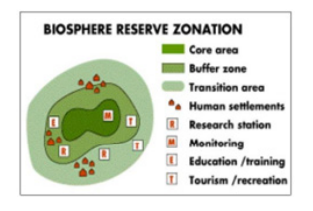Biodiversity-biodiversity-conservation / Biodiversity & Biodiversity Conservation / What is Biosphere Reserve?
What is Biosphere Reserve?
- Biosphere reserves are sites established by countries and recognized under UNESCO’s Man and the Biosphere (MAB) Programme to promote sustainable development based on local community efforts and sound science. The programme of Biosphere Reserve was initiated by UNESCO in 1971. The purpose of the formation of the biosphere reserve is to conserve in situ all forms of life, along with its support system, in its totality, so that it could serve as a referral system for monitoring and evaluating changes in natural ecosystems. The first biosphere reserve of the world was established in 1979, since then the network of biosphere reserves has increased to 631 in 119 countries across the world. Presently, there are 18 notified biosphere reserves in India.
- Biosphere Reserves involve local communities and all interested stakeholders in planning and management. They integrate three main “functions”:
- Conservation of biodiversity and cultural diversity
- Economic development that is socio-culturally and environmentally sustainable
- Logistic support, underpinning development through research, monitoring, education and training
- These three functions are pursued through the Biosphere Reserves’ three main zones:

- Core Areas
- It comprises a strictly protected zone that contributes to the conservation of landscapes, ecosystems, species and genetic variation
- Buffer Zones
- It surrounds or adjoins the core area(s), and is used for activities compatible with sound ecological practices that can reinforce scientific research, monitoring, training and education.
- Transition Area
- The transition area is where communities foster socio-culturally and ecologically sustainable economic and human activities.
| S.No. | Name | Date of Notification | Area (in km2) | Location (State) |
| 1 | Nilgiri | 01.09.1986 | 5520 (Core 1240 & Buffer 4280) | Part of Wayanad, Nagarhole, Bandipur and Madumalai, Nilambur, Silent Valley and Siruvani hills (Tamil Nadu, Kerala and Karnataka). |
| 2 | Nanda Devi | 18.01.1988 | 5860.69 (Core 712.12, Buffer 5,148.570) & T. 546.34) | Part of Chamoli, Pithoragarh, and Bageshwar districts (Uttarakhand). |
| 3 | Nokrek | 01.09.1988 | 820 (Core 47.48 & Buffer 227.92, Transition Zone 544.60) | Part of Garo hills (Meghalaya). |
| 4 | Great Nicobar | 06.01.1989 | 885 (Core 705 & Buffer 180) | Southern most islands of Andaman And Nicobar (A&N Islands). |
| 5 | Gulf of Mannar | 18.02.1989 | 10,500 km2 Total Gulf area (area of Islands 5.55 km2) | Indian part of Gulf of Mannar between India and Sri Lanka (Tamil Nadu). |
| 6 | Manas | 14.03.1989 | 2837 (Core 391 & Buffer 2,446) | Part of Kokrajhar, Bongaigaon, Barpeta, Nalbari, Kamprup and Darang districts (Assam) |
| 7 | Sunderbans | 29.03.1989 | 9630 (Core 1700 & Buffer 7900) | Part of delta of Ganges and Brahamaputra river system (West Bengal). |
| 8 |
Simlipal |
21.06.1994 | 4374 (Core 845, Buffer 2129 & Transition 1400 | Part of Mayurbhanj district (Orissa). |
| 9 | Dibru-Saikhowa | 28.07.1997 | 765 (Core 340 & Buffer 425) | Part of Dibrugarh and Tinsukia Districts (Assam) |
| 10 | Dehang-Dibang | 02.09.1998 5111.50 | (Core 4094.80 &Buffer 1016.70) | Part of Siang and Dibang Valley in Arunachal Pradesh. |
| 11 |
Pachmarhi |
03.03.1999 | 4926 | Parts of Betul, Hoshangabad and Chindwara districts of Madhya Pradesh. |
| 12 | Khangchendzonga | 07.02.2000 | 2619.92 (Core 1819.34 & Buffer 835.92) | Parts of Khangchendzonga hills and Sikkim. |
| 13 | Agasthyamalai | 12.11.2001 | 1828 | Neyyar, Peppara and Shendurney Wildlife Sanctuaries and their adjoining areas in Kerala. |
| 14 | Achanakamar - Amarkantak |
30.3.2005 | 3835.51 (Core 551.55 & Buffer 3283.86) | Covers parts of Anupur and Dindori districts of M.P. and parts of Bilaspur districts of Chhattishgarh State. |
| 15 | Kachchh | 29.01.2008 | 12,454 km2 | Part of Kachchh, Rajkot, Surendra Nagar and Patan Civil Districts of Gujarat State |
| 16 | Cold Desert | 28.08.2009 | 7770 | Pin Valley National Park and surroundings; Chandratal and Sarchu&Kibber Wildlife Sancturary in Himachal Pradesh |
| 17 | Seshachalam Hills | 20.09.2010 | 4755.997 | Seshachalam Hill Ranges covering parts of Chittoor and Kadapa districts of Andhra Pradesh |
| 18 | Panna | 25.08.2011 | 2998.98 | Part of Panna and Chhattarpur districts in Madhya Pradesh |

